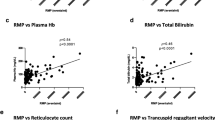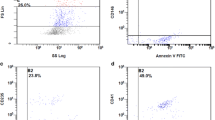Abstract
Increased thrombocyte activation leads to a higher likelihood of coagulation in sickle-cell disease. On the other hand, chronic inflammation and endothelial cell activation promote vaso-occlusion. The effect of circulating microparticles derived from erythrocytes, monocytes, thrombocytes, and endothelial cells on the vaso-occlusive process is unclear. This study aims to analyze the relationship between sickle-cell disease and miscellaneous organ complications by defining the circulating microparticles during the steady-state and painful crisis periods in 45 patients with sickle-cell disease. Microparticle analysis was conducted using an eight-parameter flow cytometric method, using CD61 PERCP, CD142PE, CD106 FITC, CD14 APC-H7, CD235a FITC, and Annexin-V APC monoclonal antibodies. Microparticle levels of sickle-cell patients were found to be significantly higher during both painful crisis and steady-state situations compared with the control group (for all, p < 0.001). Among these microparticles, levels of erythrocyte microparticles (eMPs) were significantly higher during crisis than in the steady-state period (eMP steady state vs. painful crisis: 7.59 ± 12.24 vs. 7.59 ± 12.24, respectively; p < 0.01). Microparticles, including eMPs, were not affected by hydroxyurea treatment. Their level did not reflect the high frequency of crisis (>3 times/year). Thrombocyte microparticle levels were found to be higher in patients with nephropathia than in those without (48.05 ± 40.23 vs. 7.67 ± 6.75, respectively; p < 0.049). Circulating microparticles seem to be involved in the pathogenesis of sickle-cell disease. eMPs may help with the management of crisis. Thrombocyte microparticles might predict renal damage induced by vaso-occlusion.


Similar content being viewed by others
References
Beutler E (2006) Disorders of hemoglobin structure: sickle-cell anemia and related abnormalities. In: Lichtman MA, Beutler E, Kıpps TJ, Seligsohn U (eds) Williams hematology, 7th edn. McGraw Hill, New York, pp 667–700
Hebbel RP (2009) Pathobiology of sickle-cell disease. In: Hoffman R, Benz EJ, Shattıl SJ (eds) Hematology basic principles and practice, 5th edn. Elsevier, Churchill Livingstone, pp 565–576
Roseff SD (2009) Sickle-cell disease: a review. Immunohematology 25:67–74
Shah MD, Bergeron AL, Dong JF, López JA (2008) Flow cytometric measurement of microparticles: pitfalls and protocol modifications. Platelets 9:365–372
Burnier L, Fontana P, Kwak BR, Angelillo-Scherrer A (2009) Cell-derived microparticles in haemostasis and vascular medicine. Thromb Haemost 101:439–451
Shet AS, Aras O, Gupta K, Hass MJ, Rausch DJ, Saba N, Koopmeiners L, Key NS, Hebbel RP (2003) Sickle blood contains tissue factor-positive microparticles derived from endothelial cells and monocytes. Blood 1(102):2678–2683
Van Beers EJ, Schaap MC, Berckmans RJ, Nieuwland R, Sturk A, van Doormaal FF, Meijers JC, Biemond BJ, CURAMA Study Group (2009) Circulating erythrocyte-derived microparticles are associated with coagulation activation in sickle-cell disease. Haematologica 94:1513–1519
George FD (2008) Microparticles in vascular diseases. Thromb Res 122(1):S55–S59
Piccin A, Murphy WG, Smith OP (2007) Circulating microparticles: pathophysiology and clinical implications. Blood Rev 21:157–171
Nieuwland R, Berckmans RJ, McGregor S, Böing AN, Romijn FP, Westendorp RG, Hack CE, Sturk A (2000) Cellular origin and procoagulant properties of microparticles in meningococcal sepsis. Blood 95:930–935
Chironi GN, Boulanger CM, Simon A, Dignat-George F, Freyssinet JM, Tedgui A (2009) Endothelial microparticles in diseases. Cell Tissue Res 335:143–151
Schnog JB, Duits AJ, Muskiet FA, ten Cate H, Rojer RA, Brandjes DP (2004) Sickle-cell disease: a general overview. Neth J Med 62:364–374
Lal A, Vichinsky EP (2005) Sickle-cell disease. In: Hoffbrand AV, Catovsky D, Tuddenham EGD (eds) Postgraduate haematology, 5th edn. Blackwell Publishing, Malden, pp 104–118
Angelot F, Seillès E, Biichlé S, Berda Y, Gaugler B, Plumas J, Chaperot L, Dignat-George F, Tiberghien P, Saas P, Garnache-Ottou F (2009) Endothelial cell-derived microparticles induce plasmacytoid dendritic cell maturation: potential implications in inflammatory diseases. Haematologica 94:1502–1512
Solovey A, Gui L, Key NS, Hebbel RP (1998) Tissue factor expression by endothelial cells in sickle-cell anemia. J Clin Invest 101:1899–19904
Solovey A, Lin Y, Browne P, Choong S, Wayner E, Hebbel RP (1997) Circulating activated endothelial cells in sickle-cell anemia. N Engl J Med 337:1584–1590
Jimenez JJ, Jy W, Mauro LM, Soderland C, Horstman LL, Ahn YS (2003) Endothelial cells release phenotypically and quantitatively distinct microparticles in activation and apoptosis. Thromb Res 109:175–180
Falanga A, Trinchero A (2013) Circulating microparticles in children with sickle cell anemia: a heterogenous procoagulant storm directed by hemolysis and fetal hemoglobin. Haematologica 98:995–996
Brogan PA, Shah V, Brachet C, Hamden A, Mant D, Klein N, Dillon MJ (2004) Endothelial and platelet microparticles in vasculitis of the young. Arthritis Rheum 50:927–936
Perez-Pujol S, Marker PH, Key NS (2007) Platelet microparticles are heterogeneous and highly dependent on the activation mechanism: studies using a new digital flow cytometer. Cytom A 71:38–45
Barteneva SN, Fasler-Kan E, Bernimoulin M, Stern NHJ, Ponomarev DE, Duckett L, Vorobjev AI (2013) Circulating microparticles: square the circle. BMC Cell Biol 14:1–21
Enjeti AK, Lincz L, Seldon M (2008) Bio-maleimide as a generic stain for detection and quantitation of microparticles. Int J Lab Hematol 14:196–199
Author information
Authors and Affiliations
Corresponding author
Rights and permissions
About this article
Cite this article
Kasar, M., Boğa, C., Yeral, M. et al. Clinical significance of circulating blood and endothelial cell microparticles in sickle-cell disease. J Thromb Thrombolysis 38, 167–175 (2014). https://doi.org/10.1007/s11239-013-1028-3
Published:
Issue Date:
DOI: https://doi.org/10.1007/s11239-013-1028-3




